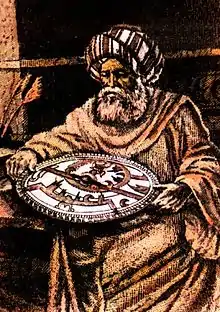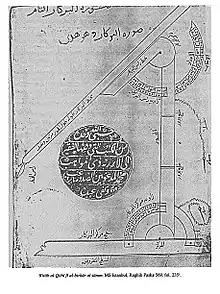Al-Battani
Abū ʿAbd Allāh Muḥammad ibn Jābir ibn Sinān al-Raqqī al-Ḥarrānī aṣ-Ṣābiʾ al-Battānī [n 1](Arabic: محمد بن جابر بن سنان البتاني) (Latinized as Albategnius, Albategni or Albatenius) (c. 858 – 929) was a Syrian[2] Arab[3][4][5] astronomer, and mathematician. He introduced a number of trigonometric relations, and his Kitāb az-Zīj was frequently quoted by many medieval astronomers, including Copernicus.[6] Often called the "Ptolemy of the Arabs",[7] al-Battani is perhaps the greatest and best known astronomer of the medieval Islamic world.[8][9][10][11]
Al-Battānī | |
|---|---|
 A modern artist's impression of al-Battānī holding an astrolabe | |
| Born | c. 858 CE |
| Died | 929 CE Qasr al-Jiss, near Samarra |
| Academic background | |
| Influences | Ptolemy |
| Academic work | |
| Era | Islamic Golden Age |
| Main interests | Mathematics, Astronomy, Astrology |
| Notable works | Kitāb az-Zīj |
| Notable ideas |
|
| Influenced | Abū al-Wafā', al-Bīrūnī, Copernicus |
Life
Little of al-Battānī's life is known other than his birthplace in Harran near Urfa, in Upper Mesopotamia, (today in Turkey) and his father's fame as a maker of scientific instruments.[6] Jabir ibn Sinan al-Harrani was likely this famous instrument maker, although this is not something that has been proven.[12] Ibn Khallikan expresses ignorance on the question of his Muslim faith, and points out that his epithet aṣ-Ṣabi’ suggests possible Sabian-sect ancestry.[13][14] Although his ancestors were likely of the Sabian-sect, he is a Muslim, as his name is Muhammad, with his kunya being Abu Abd Allah.[12] The Encyclopædia Britannica Eleventh Edition stated that he had noble origins as an Arab prince,[15] but traditional Arabic biographers make no mention of this.[6] Between 877 and 918/19, over a forty-year period, he lived in the ancient city of Raqqa, in north central Syria, recording his astronomical observations. He died at Qasr al-Jiss, which is located near Samarra, Iraq.[12] He was returning from Baghdad to al-Raqqa after resolving a dispute on behalf of the people of al-Raqqa.[12]
Astronomy

One of al-Battānī's best-known achievements in astronomy was the determination of the solar year as being 365 days, 5 hours, 46 minutes and 24 seconds, which is only 2 minutes and 22 seconds off.[14]
Another of al-Battānī's accomplishments is that he concluded how an annular solar eclipse occurs.[12] He did this by observing that the radius between the Earth and the Sun changes throughout the year.[12] This led him to arrive to the conclusion that when the Sun is farthest from the Earth, an annular solar eclipse occurs.[12] He was the first to make this observation and inference.
The twelfth-century Egyptian encyclopedist al-Qifṭī, in his biographical history Ta’rīkh al-Ḥukamā’, mentions al-Battānī’s contribution to advances in astronomical observation and calculations based on Ptolemy’s Almagest.[1]
Al-Battānī amended some of Ptolemy's results and compiled new tables of the Sun and Moon, long accepted as authoritative.[15] Some of his measurements were more accurate than ones taken by Copernicus many centuries later and some ascribe this phenomenon to al-Battānī's location lying closer to the equator such that the ecliptic and the Sun, being higher in the sky, are less susceptible to atmospheric refraction.[14] Al-Battānī observed that the direction of the Sun's apogee, as recorded by Ptolemy, was changing.[16] [n 2]
Al-Battānī's work was instrumental in the development of science and astronomy.[14] Copernicus, in his book that initiated the Copernican Revolution, the De Revolutionibus Orbium Coelestium, quotes his name no fewer than 23 times,[17] and also mentions him in the Commentariolus.[18] Tycho Brahe, Riccioli, Kepler, Galileo and others frequently cited him or his observations.[6] He also influenced Jewish rabbis and philosophers such as Abraham ibn Ezra, Abraham bar Hiyya, and Maimonides.[12] His data is still used in geophysics.[19] The major lunar crater Albategnius is named in his honor.[20]
Among his Innovations
- Introduction [n 3] of the use of sines in calculation and partially that of tangents.[15]
- Calculation of the values for the precession of the equinoxes (54.5" per year, or 1° in 66 years) and the obliquity of the ecliptic (23° 35').[14]
- Use of a uniform rate for precession in his tables, choosing not to adopt the theory of trepidation attributed to his colleague Thabit ibn Qurra.
Mathematics
In mathematics, al-Battānī produced a number of trigonometrical relationships:
He also solved the equation sin x = a cos x discovering the formula:
He gives other trigonometric formulae for right-angled triangles such as:[14]
Al-Battānī used al-Marwazi's idea of tangents ("shadows") to develop equations for calculating tangents and cotangents, compiling tables of them. He also discovered the reciprocal functions of secant and cosecant, and produced the first table of cosecants, which he referred to as a "table of shadows" (in reference to the shadow of a gnomon), for each degree from 1° to 90°.[21]
Using these trigonometrical relationships, Al-Battānī created an equation for finding the qibla, which Muslims must face in each of the five prayers they practice everyday.[22] The equation he created did not give accurate directions, as it did not take into account the fact that Earth is a sphere.[22] The relationship Al-Battānī used was fairly precise when a person is in Mecca, or close to Mecca, but resulted in more and more inaccurate results as one gets more distant from Mecca.[22] However, it was still a widely used method at the time. The equation is as follows:[22]
Works
- Kitāb az-Zīj (كتاب الزيج or زيج البتاني, "Book of Astronomical Tables"); Al-Battānī's magnum opus reflects Ptolemaic and Greco-Syriac astronomical theory, with Indo-Persian influences to a lesser degree.[6][23] The word zij is a Persian word that was used to describe a rug warp.[12] Al-Battānī's zij contains a description of a quadrant instrument.[24] Of the many early translations into Latin and Spanish, a Latin version De Motu Stellarum by Plato of Tivoli (1116), was reprinted with annotations by Regiomontanus,[15] and again at Bologna in 1645. The original manuscript is preserved at the Vatican library in Rome.[15]
- De scientia stellarum (in Latin). Bologna: Vittorio Benacci, eredi. 1645.
- Kitāb az-Zīj aṣ-Ṣābi’ (كتاب الزيج الصابئ) published by Carlo Alfonso Nallino (1899-1907) under the Latin title Al-Battānī sive Albatenii opus astronomicum: ad fidem codicis Escurialensis Arabice editum;[25] a multi-volume scientific treatise on geography and astronomical chronology from an Arabic manuscript with Latin annotations. The manuscript is held at the Escorial library.
- Arbaʻu Maqālāt (أربع مقالات, "Four discourses");[26] a commentary on Ptolemy’s Quadripartitum de apotelesmatibus e judiciis astrorum, known as the Tetrabiblos. The tenth-century encyclopedist Isḥāq al-Nadīm in his Kitāb al-Fihrist lists al-Battānī among a number of authors of commentaries on this work.[27][n 4]
- Maʻrifat Maṭāliʻi l-Burūj (معرفة مطالع البروج, "Knowledge of the rising-places of the zodiacal signs")[n 5][13]
- Kitāb fī Miqdār al-Ittiṣālāt (كتاب في مقدار الاتصالات); treatise on the four quarters of the sphere.
In popular culture
A ship in Star Trek: Voyager is named after Al-Battānī, known as the USS Al-Batani, on which Kathryn Janeway originally served.
See also
- List of Arab scientists and scholars
- Zij
Notes
- Al-Qifṭī gives his name: Ibn Sinān Abū ‘Abd Allāh Al-Harranī, known as al-Battānī and mentions that Said al-Andalusi in his book Kitāb al-Qāsī (كتاب القاصى) gives: Abū Jāfar Muḥammad ibn Sinān ibn Jābir al-Harranī, known as al-Battānī, [1]
- In modern heliocentric terms this is due to the changing direction of the eccentricity vector of the Earth's orbit.
- Probably independently of the 5th-century Indian astronomer Aryabhata
- Ptolemy's treatise was translated into Arabic by Ibrahim ibn al-Salt and this translation was amended by Isḥāq.
- This may have been about zodiac amplitude calculations. See McGuckin. [28]
Citations
- Qifṭī 1903, p. 280.
- Darke, Diana (2018-05-01). The Merchant of Syria: A History of Survival. Oxford University Press. ISBN 978-0-19-093481-1.
- C.A., Nallino. "al-BATTĀNĪ". Brill. doi:10.1163/1573-3912_islam_sim_1289. Cite journal requires
|journal=(help) - "Al-Battānī | Arab astronomer and mathematician". Encyclopedia Britannica.
- "Al-Battani - Oxford Reference".
- Hartner, Willy (1970–1980). "Al-Battānī, Abū ʿAbd Allāh Muḥammad Ibn Jābir Ibn Sinān al-Raqqī al-Ḥarrānī al–Ṣābi". Dictionary of Scientific Biography. New York: Charles Scribner's Sons. ISBN 978-0-684-10114-9.
- Barlow, Peter; Kater, Henry; Herschel, Sir John Frederick William (1856). The Encyclopaedia of Astronomy: Comprising Plane Astronomy. R. Griffin. p. 494.
- Schlager, Neil; Lauer, Josh (2001). Science and Its Times: 700-1449. Gale Group. p. 291.
- Griffin, Rosarii (2006). Education in the Muslim World: different perspectives. Symposium Books Ltd. p. 31.
- Angelo, Joseph A. (2014). Encyclopedia of Space and Astronomy. Infobase Publishing. p. 78.
- Ben-Menaḥem, Ari (2009). Historical Encyclopedia of Natural and Mathematical Sciences. Springer Science & Business Media. p. 541.
- "KushyĀr Ibn LabbĀn BĀshahrĪ, Abu-'l-Ḥasan, Al-JĪlĪ". Complete Dictionary of Scientific Biography. 7: 507–516. 2008 – via Gale eBooks.
- Khallikān (ibn) 1868, p. 317.
- O'Connor, John J.; Robertson, Edmund F., "Al-Battani", MacTutor History of Mathematics archive, University of St Andrews.
- Chisholm, Hugh, ed. (1911). . Encyclopædia Britannica. 1 (11th ed.). Cambridge University Press. p. 491.
- Singer, Charles Joseph (1997). A short history of science to the nineteenth century. Courier Dover Publications. p. 135. ISBN 978-0-486-29887-0.
- Hoskin, Michael (1999-03-18). The Cambridge Concise History of Astronomy. Cambridge University Press. p. 58. ISBN 9780521576000.
- Freely, John (2015-03-30). Light from the East: How the Science of Medieval Islam Helped to Shape the Western World. I.B.Tauris. p. 179. ISBN 9781784531386.
- Dalmau, W. (1997) CRITICAL REMARKS ON THE USE OF MEDIEVAL ECLIPSE RECORDS FOR THE DETERMINATION OF LONG-TERM CHANGES IN THE EARTH'S ROTATION Archived 2012-10-23 at the Wayback Machine', Surveys in Geophysics 18: 213-223.
- Ewen A. Whitaker, Mapping and Naming the Moon (Cambridge University Press, 1999), p.61.
- "trigonometry". Encyclopædia Britannica. Retrieved 2008-07-21.
- Glen Van Brummelen (2013). "Seeking the Divine on Earth: The Direction of Prayer in Islam". Math Horizons. 21: 15–17 – via JSTOR.
- E. S. Kennedy, A Survey of Islamic Astronomical Tables, (Transactions of the American Philosophical Society, New Series, 46, 2), Philadelphia, 1956, pp. 10–11, 32–34.
- Moussa, Ali (2011). "Mathematical Methods in Abū al-Wafāʾ's Almagest and the Qibla Determinations". Arabic Sciences and Philosophy. 21 (1): 1–56. doi:10.1017/S095742391000007X.
- Battani (al-) 1899.
- Khallikān (ibn) 1868, pp. 318, 320.
- Nadīm (al-), p. 640.
- Khallikān (ibn) 1868, p. 319, n.2.
References
- Al-Battānī sive Albatenii, Opus Astronomicum. Ad fidem codicis escurialensis arabice editum, ed. by Carlo Alfonso Nallino. Milan, Ulrico Hoepli, 1899-1907 [= Pubblicazioni del Reale Osservatorio di Brera in Milano, nr. XL], 412 + 450 + 288 pp. (anast.: I-III, [La Finestra editrice], Lavis 2002 ISBN 978-8888097-26-8
- Battani (al-), Muḥammad ibn Jabir (1899). Nallino, Carlo Alfonso (ed.). Al-Battānī sive Albatenii opus astronomicum: ad fidem codicis Escurialensis Arabice editum (Kitāb Zīj al-Ṣābī’) (in Arabic). 3. Milan: Mediolani Insubrum: Prostat apud Urlichum Hoeplium. ISBN 978-8888097-26-8.
- Khallikān (ibn), Aḥmad i. M (1868). Mac Guckin de Slane, William (ed.). Wafayāt al-A’yān wa Anbā’ (Ibn Khallian’s Biographical Dictionary). III. Paris & London: W.H. Allen. p. 317.
- Nadīm (al-), Abū al-Faraj Muḥammad ibn Isḥāq Abū Ya’qūb al-Warrāq (1970). Dodge, Bayard (ed.). The Fihrist of al-Nadim; a tenth-century survey of Muslim culture. New York & London: Columbia University Press.
- Qifṭī (al-), Jamāl al-Dīn Abū al-Ḥasan ‘Alī ibn Yūsuf (1903). Lippert, Julius (ed.). Ta’rīkh al-Ḥukamā’ (in Arabic). Leipzig: Theodor Weicher. p. 280.
- Sarton, George (1947). Introduction to the History of Science. I. Baltimore: Williams and Wilkins. p. 602.
- Smith, David Eugene (1925) [1923]. History of Mathematics. I. Boston: Ginn. p. 175.
- Hartner, Willy (1970–1980). "Al-Battānī, Abū ʿAbd Allāh Muḥammad Ibn Jābir Ibn Sinān al-Raqqī al-Ḥarrānī al–Ṣābi". Dictionary of Scientific Biography. New York: Charles Scribner's Sons. ISBN 978-0-684-10114-9.
- O'Connor, John J.; Robertson, Edmund F., "Abu Abdallah Mohammad ibn Jabir Al-Battani", MacTutor History of Mathematics archive, University of St Andrews.
External links
- Dalen, Benno van (2007). "Battānī: Abū ʿAbd Allāh Muḥammad ibn Jābir ibn Sinān al‐Battānī al‐Ḥarrānī al‐Ṣābiʾ". In Thomas Hockey; et al. (eds.). The Biographical Encyclopedia of Astronomers. New York: Springer. pp. 101–3. ISBN 978-0-387-31022-0. (PDF version)
- Weisstein, Eric Wolfgang (ed.). "Albategnius (ca. 858–929)". ScienceWorld.
 Texts on Wikisource:
Texts on Wikisource:
- Gilman, D. C.; Peck, H. T.; Colby, F. M., eds. (1905). "al-Battani, Mohammed ibn Jabir ibn Sinan". New International Encyclopedia (1st ed.). New York: Dodd, Mead.
- "Albategnius". Encyclopædia Britannica. 1 (11th ed.). 1911. p. 491.
- "al-Battani". New International Encyclopedia. 1920.
